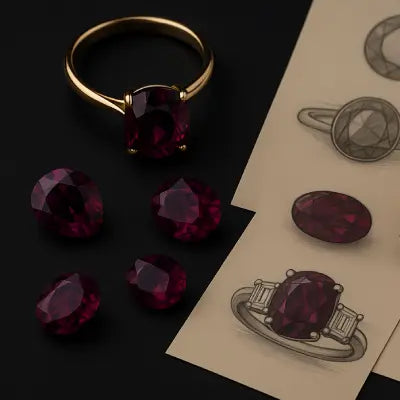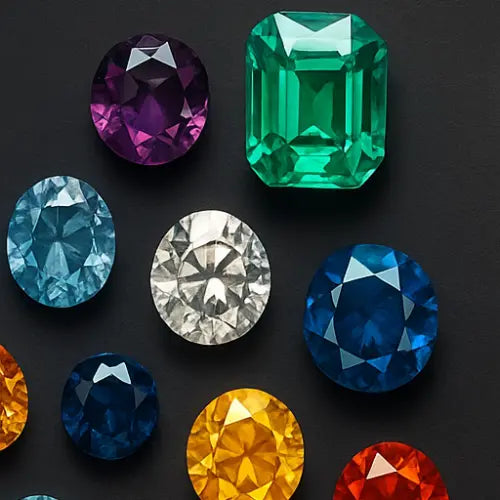Alexandrite is a gemstone of rare contradiction. One moment, it shines a crisp green under the brilliance of the sun; the next, it deepens into a lush raspberry hue under warm evening light. This extraordinary shift in color is not a trick of the eye but a natural optical effect, one that makes alexandrite unlike any other stone in the world. Its changing nature has fascinated gem collectors, mineralogists, and royalty alike for nearly two centuries. Today, this fascination is carried forward in custom jewelry creations, where each alexandrite piece becomes a personal expression of transformation and depth. But its story, like its color, is layered and elusive, unfolding gradually through science, myth, and discovery.
See the magic of alexandrite for yourself: browse the selection of truly one-of-a-kind rings and earrings at Robin Woolard, where each piece is crafted to showcase the stone’s unique shift in color and its quietly captivating beauty.
A Gem of Omens and Ancient Myths
Alexandrite’s most famous trait is its ability to change color, comes from a rare optical phenomenon known as pleochroism. This effect occurs when trace amounts of chromium in the gem interact with light in complex ways, causing different wavelengths to be absorbed or reflected depending on the source of illumination. Sunlight brings out its green to bluish hues. Candlelight or incandescent bulbs reveal deep reds and purples. The contrast can be subtle or dramatic, depending on the environment and the quality of the stone.
This transformation captivated jewelers and mystics alike. In earlier centuries, such shifting colors were thought to hold spiritual meaning. Sudden changes were seen as omens of danger, warning, or transformation. Warriors carried the stone not for beauty but for its perceived power to foretell calamity. In this sense, alexandrite became more than a rare stone; it became a watchful amulet.

In the Indian epic Mahabharata, written between 400 BCE and 400 CE, ancient poets describe mystical gems capable of changing color and influencing fate. Scholars believe these may have been early mentions of chrysoberyls with similar optical effects. In early legends, these gemstones were seen as signs of abundance, status, and blessings from the gods. They were believed to guide their owners toward better fortune and shield them from harm. While we cannot know for certain whether these accounts refer to alexandrite itself, the similarities are uncanny.
Imperial Discovery: From Ural Mountains to Royal Courts
The first known specimens of alexandrite were unearthed in Russia in the 1830s within the remote mountain ranges that stretch across the heart of Eurasia. Though chrysoberyl, the mineral family to which alexandrite belongs, had been known since antiquity, this variant was something entirely new. Embedded in rough rock, it was initially mistaken for emerald, but a curious color change under candlelight set it apart.
That duality captured the imagination of the Russian elite, and soon after, the gem was named in honor of the young heir to the throne, later crowned Tsar Alexander II. Throughout the 19th century, alexandrite became deeply embedded in Russian high society. At the imperial court, it was worn not only as decoration but as a symbol of cultural pride. Among the most lavish displays of the stone was a jewel suite belonging to Empress Alexandra Fyodorovna, mother of Alexander II. Her ceremonial traditional Russian headdress was famously adorned with massive Ural alexandrites. The court painter Franz Krüger immortalized the empress in a state portrait, dressed in a traditional folk costume embroidered with gems, with the alexandrites dominating the scene. Earrings, bracelets, and a grand necklace all exhibit this gem, placing the stone in the visual history of a dynasty.
Though originally found in Russian mines, the stone has since been discovered in other corners of the globe. Toward the end of the 19th century, alexandrite was discovered in Brazil, with additional sources later uncovered in Sri Lanka and various regions of Africa. While stones from these locations vary in tone and clarity, they share the signature shift that defines true alexandrite. By day, certain stones show a teal-green glow that transforms into a deep raspberry under evening light, while others transition between earthy olive tones and velvety plum shades.
Global Rarity and Legendary Specimens
In modern gemological history, alexandrite rose to prominence not only because of its rarity but also due to its unmistakable personality. It is a stone that never looks the same twice, adapting to its environment with poetic fluidity. For jewelers, this made it an irresistible challenge. Designers learned to place the stone in pieces such as alexandrite natural rings and earrings meant to travel through different settings, from ballroom to twilight garden, allowing the full range of color to be revealed with movement and time.
The size and clarity of alexandrite crystals are also significant in determining value. Stones over one carat are considered rare, and those with a sharp, dramatic color shift are the most prized. Over the last two centuries, a handful of exceptional specimens have emerged.
One of the most extraordinary alexandrite discoveries to date is the Sauer Alexandrite, an uncut gemstone weighing an astonishing 122,400 carats. It was unearthed in 1967 in Bahia, Brazil, by renowned jeweler Jules Roger Sauer. Instead of selling or cutting the stone, Sauer kept it in his private collection, later displayed at the Museu Amsterdam Sauer in Rio de Janeiro. Though once a centerpiece, it has reportedly disappeared from public view, sparking rumors of a private sale. Equally famed is the Kochubei Druse, a cluster of 22 alexandrite crystals from 19th-century Russia, originally owned by Count Perovskii and later acquired by Prince Petr Kochubei, a key figure in Russian science and culture. It is found in Moscow’s Mineralogical Museum. Other museum-quality alexandrites include a 65.7-carat cut stone from Sri Lanka at the Smithsonian and large Sri Lankan gems at the British Museum. Though Russian stones are smaller, their vibrant color change makes them the most prized.
Despite advances in technology, synthetic versions, and global mining, natural alexandrite remains a category apart. No man-made copy can truly replicate the precise, unpredictable transition between hues that defines this gem. Natural alexandrite remains indifferent to explanation. It changes when it wants to, refuses to follow rules, and reveals its full character only under the right conditions. In that constant change, it carries something few gems ever do: presence.
What Is the Best Cut for an Alexandrite?
The cut of an alexandrite plays a critical role in how its colors behave under different lighting. Precision is key: a well-cut stone will reveal the gem’s full range of hues. Oval cuts and rounded cushions are often preferred because they provide a wide viewing area and enhance both the green and red tones. These shapes also offer a sense of depth, allowing the color shift to unfold across the surface with dramatic effect. This makes alexandrite a popular choice in Bespoke Jewelry design, where every detail — from cut to setting — is tailored to highlight the stone’s unique character.

Today, whether adorning the hands of modern collectors or showcased in prestigious museum collections, alexandrite continues to enchant and intrigue, affirming its place as the imperial chameleon among gemstones. Its true beauty lies not only in its rarity or changing hues but in its enduring ability to captivate, inspire, and defy expectation
How to Choose Alexandrite?
Finding the right alexandrite isn’t just about appearance — it’s about understanding the details that set this gem apart. From its unique optical behavior to its rarity, several factors should guide your decision:
- Color Shift Strength: The most desirable alexandrites shift clearly from green in natural light to red under warmer lighting. Look for stones where the transition is bold and well-defined — ideally showing at least an 80% shift.
- Clarity and Internal Texture: Transparent stones with minimal flaws are considered top-tier, though faint internal patterns, such as silky threads, can add value — especially if they produce the rare cat’s-eye effect, where a narrow beam of light seems to slide across the surface.
- Size and Weight: Alexandrites weighing more than one carat are unusual. Stones above three carats are extremely scarce and often enter museum collections or private vaults.
- Verification and Certification: Choose gems that come with a certificate from a respected gemological lab. This confirms their authenticity, natural origin, and whether any treatments have been applied.
The Light That Shifts: Alexandrite’s Optical Alchemy
- Moves between green and raspberry hues with the changing light, revealing new sides of itself throughout the day.
- This transformation is not an illusion but nature’s rare chemistry — chromium, crystal, and angle, working in tandem.
- Well-cut stones — especially ovals and cushions — act like windows, magnifying the drama of color in motion.
- The stone responds not just to light, but to the quality of light — sunlight, candlelight, twilight — all casting a different spell.
From Mountain Roots to Museum Halls
- Unearthed in the Ural Mountains, then found again in Brazil, Sri Lanka, and Africa — each region lending its own tonal signature
- No two stones are alike; each one holds its own balance between light and shadow, warmth and coolness.
- The legendary Sauer Alexandrite remains unmatched in size, while the Kochubei Druse holds court in Moscow’s collections.
- Despite synthetic attempts, no replica can capture the unpredictability, the refusal to settle, that defines true alexandrite.






